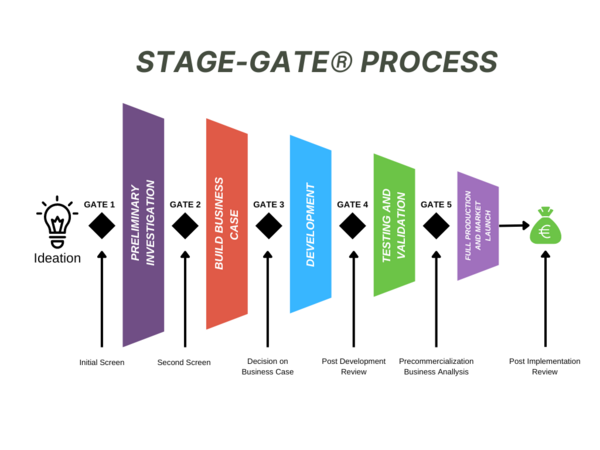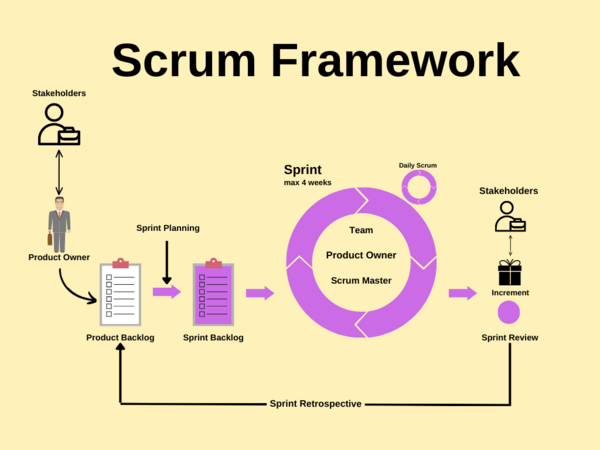The Agile Stage-Gate Model
Contents |
Abstract
The Agile-Stage-Gate model is a hybrid project management approach for the development of physical products. As the name may suggest, the model aims to merge two different, almost opposite models to create a new flexible but structured solution. Currently, gating systems are considered “too linear, too rigid, and too planned” (Edwards et al. 2020)[1]: generally, unable to keep up with the high degree of uncertainty that characterizes modern projects. Agile methodologies (Scrum above all, but also other practices such as Design Thinking and Lean Startup) can be embedded inside stages to deal with the contingencies of the project. In practice, the Stage-Gate® continues to give the project a step-by-step path from ideation to the launch in the market, while Agile is applied as a tool in daily activities. According to the latest studies, the results from on-the-field experiences state that the Agile-Stage-Gate can improve the product development process in several ways, such as by making the design processes more flexible, achieving higher productivity, supporting better communication and collaboration in teams, and higher team morale [1]. Some studies also highlighted a higher success rate and a faster development process [1]. The model is applied by large companies such as Lego, Volvo [1] and Danfoss, and it has also yielded encouraging results in small-medium enterprises [1]. However, it poses new challenges to managers in allocating resources, building complete multidisciplinary teams [1], organizing meetings [1], and overcoming the skepticism of the management. Another article has been written about the hybrid Agile-Stage-Gate model. This article not only aims to investigate the new hybrid approach's origins, nature, and functioning from its foundations, but it also wants to provide recommendations on when to use a specific hybrid model based on the latest scientific contributions. Furthermore, the article will report the most suitable metrics to evaluate Agile-Stage-Gate projects from a portfolio perspective. In conclusion, a brief reflection on the status quo of the developmental approaches against what the Agile-Stage Gate proposes, followed by the limitations of the model.
Why the Hybrid Model
Managing Innovation through the Stage-Gate®
In the second half of the 20th century, gating systems for project management have spread all over the world and become a standard in riding the lifecycle of innovation projects, especially in new product development. One of the most famous gating systems is the Stage-Gate® model, formulated by Cooper in 1983, a strategic management tool that gives a rigid and plan-based structure to the idea-to-launch process, alternating decision-making stations called Gate to operative Stage. A Gate is a set of expected results that must be met by the project leader to access the next Stage. The “exit criteria” vary from one gate to another, or from one project to another, but generally, they should be a set of benchmarks for the project's strategic, marketing, and financial aspects. Initially, these standards are mostly qualitative, while they gradually become more quantitative in the final stages[2]. The evaluation of the project against gate criteria needs to be assessed by an experienced manager, whose knowledge plays a key role in the decision-making process. Management oversees the greenlighting of the heavy spending decision through the path and helps the team meet the deadlines. Furthermore, management's commitment and support are fundamental in aligning the project's development with the organization's objectives [3]. The output of a Gate results in a Go/Kill/Hold/Recycle. If the deliverables satisfy the exit criteria, the project can move on to the next Stage, “a set of required or recommended best-practice activities needed to progress the project to the next gate or decision point” (Cooper, 2008) [4]. In each stage, cross-functional types of analysis are carried out concurrently by multidisciplinary teams of individuals from different areas of the company[2], using traditional project management tools such as “Gantt chart, milestones, and critical path” [5](Cooper, Sommer, 2018). Since every stage has incremental costs, the knowledge acquired thus mitigates the risk. It offers a broader vision and a more analytical perspective to decision-makers, who can evaluate the project using objective data rather than relying on intuitions [2]. An example of a traditional Stage-Gate® model introduced by Cooper in his article "Stage-gate systems: A new tool for managing new products"(1990) is reported below [2]:

- Preliminary assessment: Users’ feedback about the concept is gathered through quick research to evaluate how the product would be perceived by the customers [2].
- Definition: Customers’ preferences are deeply analyzed in this stage. Thus, the team can identify the basic principles of the future product and assess the first approximate financial and technical prospects. Here, legal matters are also considered[2].
- Development: the design of the product is finally developed, and all operative needs and processes are clearly defined [2].
- Validation: once the product is prototyped and ready to be produced, the company must test it to evaluate its quality. The customer plays a crucial role in helping the development team to understand if the usability of the product is by what has been stated in the previous stages. After the first tests, more information is available and can be used to improve the product and the production process. Furthermore, considering the new data, the financial prospect of the entire project can be reassessed [2].
- Launch: The product is finally launched on the market, and production can start [2].
The Agile-Stage Gate: need for flexibility
At the executive level, the two questions “Are we doing the right things” and “Are we doing things right?” are more and more present and call for the review of existing strategic and operative plans [5]. In Stage-Gate®, a detailed product proposal is well-defined before starting a project, and project-related costs are evaluated and approved upfront. [5]. Moreover, in the traditional method, the team follows a sequential path based on a predetermined schedule and project blueprint, and the customer is rarely involved in the process, but this approach clashes with the dynamics of the current environment, which asks companies to be flexible and adapt to the market’s changes[7]. In fact, the traditional model has been criticised in several respects. Having project details fixed too early may require rework or compromises in later stages, with negative effects on the time-to-market and the quality of the output. Moreover, excessive bureaucracy makes the model too rigid. In general, Stage-Gate is "not adaptive enough and does not encourage experimentation"(Edwards et al. 2019)[1]. For this reason, the hybrid Agile-Stage Gate (ASG) approach gained interest among scholars and practitioners as a possible alternative that blends benefits from both models, thus balancing “discipline and agility” [8] (Brandl et al. 2018). Agile project management is a project management approach that handles complexity by iterative work on the product, adapting its features to the emergent business needs in the process [9]. Even if most of the agile frameworks were developed during the second half of the 20th century, the Agile philosophy was officially formulated by a group of developers only in 2001, with the publication of the Agile Manifesto [10]. As affirmed by Abbas et al. (2008) a method, to be considered agile, should be “Adaptive”, “Iterative and Incremental”, and “People Oriented”[11].
- Adaptive: ready to adjust the product, or the “method itself”(Abbas et al. 2008)[11], to what is needed after each iteration, based on technological advancements and feedback from previous iterations.[11]
- Iterative and Incremental: in a software environment, the features of the product are defined iteratively, and incrementally improved. At the end of each iteration, the customer is involved in the evaluation to gather his opinions and ideas during the process.[11]
- People Oriented: the Agile philosophy considers the method applied as a mere tool to support the team in delivering the best possible outcome. The role of people, both the team and the customer, is pivotal in agile philosophy. [11]
Generally, Agile is an “umbrella” that groups a wide number of frameworks. (Asana). In the context of the Stage-Gate, the Scrum framework seems to be the most apt to be fitted into the stages (Cooper, 2016). In a nutshell, Scrum is an agile project management methodology inspired by rugby that through time-boxed iterations(“Sprint”) aims to deliver a certain improvement, called “Increment”, to the product in the development pipeline. At the end of each sprint, the outcomes are evaluated with relevant stakeholders in a review session (“Sprint review”). Stakeholder feedback helps the team to update the Product Backlog with new functionalities to be added in the next sprints. Then, the whole sprint is reviewed in a retrospective meeting (“Sprint Retrospective”), where the team discusses what worked well and what did not and pinpoint the key area of improvement for future iterations. [12]

The Scrum team consists of three main figures:
- Scrum Master is the team leader who helps members apply Scrum methods and practices in daily activities. The Scrum Master works on the interface between the team and the organization.[12]
- Product Owner, who translates the stakeholder needs into achievable objectives, grouped in the Product Backlog. Moreover, The Product Owner is accountable for listing, prioritizing, and communicating the items in the Product Backlog to the team.[12]
- Developers, the professionals who actually “create” the Increment. The Developers plan the Sprint together and work to meet the quality criteria defined in the Definition of Done, thus realizing an Increment.[12]
However, other Agile methodologies can be used to improve the existing product development roadmap, such as Lean Startup and Design Thinking, as shown by Cocchi et al. (2021). According to the studies by Karlstrom and Runeson reported by Cooper Cite error: Closing </ref> missing for <ref> tag
Cite error:
<ref> tags exist, but no <references/> tag was found